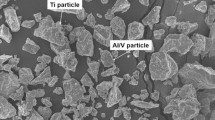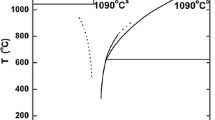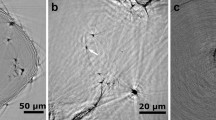Abstract
Design and processing of new materials with improved high-temperature properties is one of the most challenging tasks of modern engineering. Among such materials, nonoxidic ceramics hold an important place. When optimizing the synthesis conditions of these new materials in an largely empirical manner, the use of analytical methods that can fully document the resulting phase compositions is of great importance. In this paper, we demonstrate the advantages of using combined microbeam X-ray diffraction and X-ray fluorescence over conventional X-ray diffraction as the characterization method in the specific case of Ti–B–C ceramics. Ceramic samples were synthesized by the pulse plasma method starting from high-purity powders of titanium, boron, graphite, and nickel. Different mixtures were heated in a pulsed fashion and sintered by combustion synthesis at various temperatures and time durations, as is the case during empirical optimization of a synthesis procedure. Conventional X-ray diffraction showed the presence of two phases at the end of the sintering process, TiB2 and TiC, irrespective of the conditions employed. Scanning μ-XRF/μ-XRD on the other hand allowed one to detect and visualize the distribution of additional phases present in the sintering products, during which a dependence on sintering conditions was apparent. The μ-XRD results showed that three phases (TiB2, TiC, and TiB) instead of two were present in samples sintered during a short time interval. The addition of metallic Ni to the initial mixture as a sintering facilitator resulted in the formation of a Ni3B phase. All phases proved to have strongly heterogeneous distributions above the 15-μm level with the presence of TiB2 anticorrelated to that of TiC and TiB, emphasizing the necessity of the use of laterally resolved methods of characterization.


Similar content being viewed by others
References
Weimer AW (1997) Carbide nitride and boride materials synthesis and processing. Chapman and Hall, London
Wen G, Li SB, Zhang BS, Guo ZX (2001) Acta Mater 49:1463–1470
Zhang XH, Zhu CC, Qu W, He XD, Kvanin VL (2002) Compos Sci Technol 62:2037–2041
Merzhanov AG, Shkiro VM, Borovinskaya IP (1967) Certif USSR No 255221
Munir ZA, Anselmi-Tamburini U (1989) Mater Sci Rep 3:277–365
Varma A, Lebrat JP (1992) Chem Eng Sci 47:2179–2194
Merzhanov AG (1994) Combust Sci Technol 98:307–336
Moore JJ, Feng HJ (1995) Prog Mater Sci 39:243–273
Michalski A, Jaroszewicz JJ, Rosinski M, Siemiaszko D (2006) Intermetallics 14:603–606
Michalski A, Jaroszewicz JJ, Rosiński M (2003) Int J SHS 12:237–246
Falkenberg G, Rickers K, Bilderback DH, Huang R (2004) A Single-bounce capillary for focusing of hard X-rays. HASYLAB Annual Report 2003
De Nolf W (2007) XRDUA. Program available from www.xrdua.ua.ac.be. Accessed 30 Oct 2007
Acknowledgements
This research was supported by the Interuniversity Attraction Poles Programme - Belgian Science Policy (IUAP VI/16). The text also presents results of GOA “Atom” (Research Fund University of Antwerp, Belgium) and of FWO (Brussels, Belgium) projects no. G.0177.03, G.0103.04 and G.0689.06.
Author information
Authors and Affiliations
Corresponding author
Rights and permissions
About this article
Cite this article
Jaroszewicz, J., De Nolf, W., Janssens, K. et al. Advantages of combined μ-XRF and μ-XRD for phase characterization of Ti–B–C ceramics compared with conventional X-ray diffraction. Anal Bioanal Chem 391, 1129–1133 (2008). https://doi.org/10.1007/s00216-008-2097-6
Received:
Revised:
Accepted:
Published:
Issue Date:
DOI: https://doi.org/10.1007/s00216-008-2097-6




